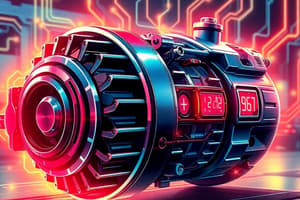Podcast
Questions and Answers
What is the primary purpose of the charging system in a vehicle?
What is the primary purpose of the charging system in a vehicle?
To generate and regulate electrical power to keep the vehicle's battery charged and supply electricity to various electrical components and systems.
What is the function of the voltage regulator in the charging system?
What is the function of the voltage regulator in the charging system?
To ensure a steady and appropriate voltage level is maintained to prevent overcharging or undercharging the battery.
How does the alternator convert mechanical energy into electrical energy?
How does the alternator convert mechanical energy into electrical energy?
The rotor spins within a stator, creating an electromagnetic field that induces an AC current.
What is the purpose of the rectifier in the charging system?
What is the purpose of the rectifier in the charging system?
What are the three main components of the charging system?
What are the three main components of the charging system?
What type of electricity is generated by the alternator, and what type is required by the vehicle's electrical system?
What type of electricity is generated by the alternator, and what type is required by the vehicle's electrical system?
What is the primary function of a voltage regulator in a vehicle's charging system?
What is the primary function of a voltage regulator in a vehicle's charging system?
What is the purpose of the support bearings in an alternator?
What is the purpose of the support bearings in an alternator?
How does the rotor generate a magnetic field in an alternator?
How does the rotor generate a magnetic field in an alternator?
What is the role of the stator in an alternator?
What is the role of the stator in an alternator?
What is the purpose of the alternator in a vehicle's charging system?
What is the purpose of the alternator in a vehicle's charging system?
What is the function of the indicators in a vehicle's charging system?
What is the function of the indicators in a vehicle's charging system?
Flashcards are hidden until you start studying
Study Notes
Charging System in Vehicles
- The charging system generates and regulates electrical power to keep the vehicle's battery charged and supply electricity to various electrical components.
Alternator Operation
- The alternator converts mechanical energy from the engine into electrical energy.
- It is driven by the engine's crankshaft via a belt.
- The alternator generates alternating current (AC) electricity through a rotor spinning within a stator, creating an electromagnetic field.
Rectification
- The alternator uses a rectifier (typically a set of diodes) to convert the AC output into direct current (DC) for the vehicle's electrical system and battery.
Voltage Regulation
- A voltage regulator monitors the output voltage of the alternator and ensures it remains within a specified range (usually around 13.5 to 14.5 volts).
- The regulator adjusts the current flowing to the rotor's field windings to maintain the proper voltage, preventing overcharging or undercharging the battery.
Battery Charging and Powering Electrical Systems
- The DC electricity produced by the alternator is used to charge the vehicle's battery, ensuring it has enough power to start the engine and operate electrical systems when the engine is off.
- The alternator also supplies electricity to various electrical components and systems in the vehicle, reducing the load on the battery.
Monitoring and Indicators
- The charging system includes indicators, such as a dashboard light or gauge, to monitor its performance and alert the operator to any problems.
Alternator Components and Functions
- Housing: protects internal components, provides airflow for cooling, and facilitates airflow to cool the alternator.
- Support Bearing: allows the rotor to spin smoothly within the housing, reducing friction and wear.
- Rotor: rotating component that generates a magnetic field when current flows through the rotor winding.
- Stator: stationary part that surrounds the rotor and consists of three sets of windings that induce an alternating current (AC) when the magnetic field sweeps through them.
Studying That Suits You
Use AI to generate personalized quizzes and flashcards to suit your learning preferences.




